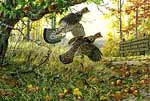On a recent night, I awoke with a start, consumed by a burning question: “Does the Earth rotate clockwise or counterclockwise?” No kidding. WTH? Further tossing and turning revealed that I didn’t know dookie about my home base. How old is the Earth? What does it weigh?
So I embraced the task of researching several of these questions. Possibly to save you from a similar sleepless night — OK, maybe I awoke simply for my 2 a.m. pee. Much better than not awakening…. — here’s some particulars about Mother Earth.
How old is the Earth?
The earth is 4.5 billion years old.
What does the Earth weigh?
1.3 X 10 ^ 25 pounds. That is, 13,000,000,000,000,000,000,000,000 pounds. It’s no wonder, then, that Atlas shrugged.
What is the circumference of the Earth?
The circumference of Earth at the equator is 24,903 miles.
Does the Earth rotate clockwise or counterclockwise?
When viewed above the North Pole, the Earth rotates counterclockwise, from west to east. This is also called a prograde rotation. Because of this direction of rotation, we see the sun rising every day in the east and setting in the west.
Is the Earth’s axis of rotation tilted?
The axis of rotation of the Earth is tilted at an angle of 23.5 degrees away from vertical, perpendicular to the plane of our planet's orbit around the sun. The tilt of the Earth's axis is important in that it governs the warming strength of the sun's energy, and thus produces the four seasons.
Does the Earth revolve clockwise or counterclockwise around the sun?
Its rotation around the sun is prograde, or west to east, which appears counterclockwise when viewed from above the North Pole, and it is common to all the planets in our solar system except Venus and Uranus
Hey, how about a picture of all this?
Sure. This school kid-level explanation seems sufficiently complete for me. Anything more would leave me in the dust. See if you can detect a booboo the young lady makes.
Hey, who cares about this anyway?
Well, more than a few years ago, the Catholic Church cared very much. And it threatened to put the screws to Galileo — really! That’s where the term comes from! — for suggesting that the Earth revolved around the Sun. Suddenly, Galileo cared very much, too. Looky here:
“On June 22nd, 1633, Galileo was shown the instruments of torture by the Inquisition and threatened with their use unless he recanted his expressed view that the Earth revolved around the Sun, instead of the other way round.
Galileo had seen the moons of Jupiter and the phases of Venus through his telescope. When he published “The Starry Messenger” in 1610, he endorsed the heliocentric theory of Nicolaus Copernicus. He proposed a theory of tides in 1616, attributing the motion of the Earth as a cause of them. In 1632 he published his “Dialogue Concerning the Two Chief World Systems,” again implying heliocentrism, which the Inquisition had formally declared to be heretical in 1616, banning books that supported it.
At his trial he was found "vehemently suspect of heresy", banned from holding or teaching heliocentric views, and was sentenced to life in prison. He was a frail 69-year-old, and the sentence was commuted on the following day to house arrest. He spent the remaining years of his life under house arrest at his villa near Florence, until he died aged 77.”
* ° * ° * ° * ° * ° * ° * ° * ° * °
As I was tidying this up for submission, I found myself listening to a podcast featuring astrophysicist Sandra Faber (No kidding. Who knew?) The discussion is really big-boy stuff, and highly recommended if you enjoyed my initial research on the Earth. You can find it





No comments:
Post a Comment